Climate change and Food Security
USA
USA
ALL CROPS
IN ALL REGIONS
AT RISK OF DECLINE
ABOVE 1.0C,
INCREASING WITH
INCREASING WARMING
AND CLIMATE CHANGE
AT RISK OF DECLINE
ABOVE 1.0C,
INCREASING WITH
INCREASING WARMING
AND CLIMATE CHANGE

United States world top food production is vital for world food security and affordable food.
The results are from computer model projections that do not capture many large adverse impacts including prolonged drought, heat waves, floods, and climate variability. Also crop diseases, weeds and pests have always been expected to increase under climate change.
The models cannot project the effects of adverse impact combinations.
These model projections then are certainly what will happen at a minimum, but they do not tell us how fast and how bad the real world impacts will be.
5th assessment 2013-2014
North America
'Observed climate trends in North America include an increased occurrence of severe hot weather events over much of the USA, decreases in frost days, and increases in heavy precipitation over much of North America (high confidence).earlier peak flow of snow melt run-off and declines in the amount of water stored in spring snowpack in snow-dominated streams and areas of western USA and Canada (very high confidence).
Many climate stresses that carry risk—particularly related to severe heat, heavy precipitation, and declining snow pack—will increase in frequency and/or severity in North America in the next decades (very high confidence).
Global warming of approximately 2°C (above the pre-industrial baseline) is very likely to lead to more frequent extreme heat events and daily precipitation extremes over most areas of North America, more frequent low-snow years, and shifts toward earlier snow-melt run-off over much of the western USA and Canada.Together with, more intense droughts, and increased precipitation variability, these changes are projected to lead to increased stresses to water, agriculture, economic activities'.(IPCC AR5 WG2 Ch26 Exec. Summary)
The most vulnerable poorest regions and the poorest in all regions are affected the worst by increased food prices.
Children are affected the most in these populations.
Climate Change and Agriculture in the
United States report USDA Feb 2013
IPCC assessment and future food security
The IPCC results are very important to understand
because it is only the IPCC assessment that is
recognized by policy makers and governments.
Climate Change and Agriculture in the
United States report USDA Feb 2013
IPCC assessment and future food security
The IPCC results are very important to understand
because it is only the IPCC assessment that is
recognized by policy makers and governments.
The results are from computer model projections that do not capture many large adverse impacts including prolonged drought, heat waves, floods, and climate variability. Also crop diseases, weeds and pests have always been expected to increase under climate change.
The models cannot project the effects of adverse impact combinations.
These model projections then are certainly what will happen at a minimum, but they do not tell us how fast and how bad the real world impacts will be.
5th assessment 2013-2014
North America
'Observed climate trends in North America include an increased occurrence of severe hot weather events over much of the USA, decreases in frost days, and increases in heavy precipitation over much of North America (high confidence).earlier peak flow of snow melt run-off and declines in the amount of water stored in spring snowpack in snow-dominated streams and areas of western USA and Canada (very high confidence).
Many climate stresses that carry risk—particularly related to severe heat, heavy precipitation, and declining snow pack—will increase in frequency and/or severity in North America in the next decades (very high confidence).
Global warming of approximately 2°C (above the pre-industrial baseline) is very likely to lead to more frequent extreme heat events and daily precipitation extremes over most areas of North America, more frequent low-snow years, and shifts toward earlier snow-melt run-off over much of the western USA and Canada.Together with, more intense droughts, and increased precipitation variability, these changes are projected to lead to increased stresses to water, agriculture, economic activities'.(IPCC AR5 WG2 Ch26 Exec. Summary)

IPCC AR5 WG2 final science draft Executive Summary DANGER LIMIT 1.0C
The effects of climate change on crop and food production are evident in several regions of the world. Negative impacts of climate trends have been more common than positive ones.
Without (successful) adaptation, local/ global temperature increases in excess of about 1oC above pre-industrial is projected to have negative effects on yields for the major crops (wheat, rice and maize) in both tropical and temperate regions,
At 1.0C local and global warming are @ the same.- at higher degrees of warming local is higher than global warming.
Studies have documented a large negative sensitivity of crop yields to extreme daytime temperatures around 30°C. These sensitivities have been identified for several crops and regions and exist throughout the growing season (high confidence). Several studies report that temperature trends are important for determining both past and future impacts of climate change on crop yields at sub-continental to global scales.
Changes in climate and CO2 concentration will enhance the distribution and increase the competiveness of agronomically important and invasive weeds.
Rising CO2 may reduce the effectiveness of some herbicides.
All aspects of food security are potentially affected by climate change, including food access, utilization, and price stability.
Nutritional quality of food and fodder, including protein and micronutrients, is negatively affected by elevated CO2,
Climate change will increase progressively the inter-annual variability of crop yields in many regions.
Under scenarios of high levels of warming, leading to local mean temperature increases of 3-4C (global 2C - 2.7C) or higher, models based on current agricultural systems suggest large negative impacts on agricultural productivity and substantial risks to global food production and security. Such risks will be greatest for tropical countries, given the larger impacts in these regions, which are beyond projected adaptive capacity, and higher poverty rates compared to temperate regions.
Increases in weather extremes
There is no consistent definition in the scientific literature of what constitutes
an extreme climatic event, and this complicates comparative global assessments.(AR5 WG1 FAQ 2.2)
All weather extremes are being increased by global climate change and are most damaging to crops,but are not captured by the crop yield projection models.
'Increases in the frequency or intensity of ecosystem disturbances such as droughts, wind storms, fires, and pest outbreaks have been detected in many parts of the world and in some cases are attributed to climate change' (AR5 WG2 TS)
'According to regional observations, most droughts and extreme rainfall events of the 1990s and 2000s have been the worst since the 1950s (Arndt et al., 2010), and certain trends in total and extreme precipitation amounts are observed'. (AR5 WG2 3.2.2)
Heatwave frequency has increased during this period (since 1950) in large parts of Europe, Asia and Australia.(IPCC AR5 WG1 Ch2. Extreme Events).
Hottest days have increased globally shows that and regionally most in: Western N. America, Western Europe,S. Mediterranean, N and West China, Mongolia, and S.E Australia. (AR5 WG1 Box 2.4, Figure 1).
Drought:
Anthropogenic forcing has contributed to the observed changes in the frequency and intensity of daily temperature extremes on the global scale since the mid-20th century. Attribution of changes in temperature extremes to anthropogenic influence is robustly seen in independent analyses using different methods and different data sets.
It is likely that human influence has substantially increased the probability of occurrence of heatwaves in some locations. (AR5 WG1 Ch 10 Climate Extremes)
Since the 1950s some regions of the world have experienced more intense and longer droughts (AR5 WG1 2.6.2.3).
Drought has increased in the Mediterranean and West Africa since 1950
For China from 1950 to 2006 longer, more severe, and more frequent soil moisture droughts have been experienced over 37% of the land area. (AR5 WG2 3.2.2)
A measure of sc-PDSI with potential evapotranspiration shows an increase
in the percentage of land area in drought since 1950. Van der Schrier et al. (2013) also finds a slight increase in the percentage of land area in severe drought using the same measure. (AR5 WG1 2.2.3)
Stream flow decreasing trends in low and mid-latitudes are consistent with recent drying and warming in West Africa,southern Europe,south and east Asia, eastern Australia,western Canada and the USA, and northern South America. (AR5 WG2 3.2.2).
Giorgi et al. (2011) indicate that ‘hydroclimatic intensity’, a measure which combines both dry spell length and precipitation intensity, has increased over the latter part of the 20th century in response to a warming climate. They show that positive trends (reflecting an increase in the length of drought and/or extreme precipitation events) are most marked in Europe, India, parts of South America and East Asia (AR5 WG1 2.6.2.3).
Future model projections project regional decreases in precipitation and in soil moisture.
Heavy precipitation events,
Anthropogenic forcing has contributed to a global-scale intensification of heavy precipitation over the second half of the 20th century. (AR5 Ch10. Climate Extremes)
Since about 1950, over land have increased in more regions than it has decreased. In North America and Europe there have been increases in either the frequency or intensity of heavy precipitation.(IPCC AR5 WG1 Ch2. Extreme Events).
Tropical cyclones of the N. Atlantic have increased in frequency and intensity of the and strongest tropical cyclones in the North Atlantic have increased since the 1970s (IPCC AR5 WG1 Ch2. Extreme Events).
The effects of climate change on crop and food production are evident in several regions of the world. Negative impacts of climate trends have been more common than positive ones.
Without (successful) adaptation, local/ global temperature increases in excess of about 1oC above pre-industrial is projected to have negative effects on yields for the major crops (wheat, rice and maize) in both tropical and temperate regions,
At 1.0C local and global warming are @ the same.- at higher degrees of warming local is higher than global warming.
Studies have documented a large negative sensitivity of crop yields to extreme daytime temperatures around 30°C. These sensitivities have been identified for several crops and regions and exist throughout the growing season (high confidence). Several studies report that temperature trends are important for determining both past and future impacts of climate change on crop yields at sub-continental to global scales.
Changes in climate and CO2 concentration will enhance the distribution and increase the competiveness of agronomically important and invasive weeds.
Rising CO2 may reduce the effectiveness of some herbicides.
All aspects of food security are potentially affected by climate change, including food access, utilization, and price stability.
Nutritional quality of food and fodder, including protein and micronutrients, is negatively affected by elevated CO2,
Climate change will increase progressively the inter-annual variability of crop yields in many regions.
Under scenarios of high levels of warming, leading to local mean temperature increases of 3-4C (global 2C - 2.7C) or higher, models based on current agricultural systems suggest large negative impacts on agricultural productivity and substantial risks to global food production and security. Such risks will be greatest for tropical countries, given the larger impacts in these regions, which are beyond projected adaptive capacity, and higher poverty rates compared to temperate regions.
Increases in weather extremes
There is no consistent definition in the scientific literature of what constitutes
an extreme climatic event, and this complicates comparative global assessments.(AR5 WG1 FAQ 2.2)
All weather extremes are being increased by global climate change and are most damaging to crops,but are not captured by the crop yield projection models.
'Increases in the frequency or intensity of ecosystem disturbances such as droughts, wind storms, fires, and pest outbreaks have been detected in many parts of the world and in some cases are attributed to climate change' (AR5 WG2 TS)
'According to regional observations, most droughts and extreme rainfall events of the 1990s and 2000s have been the worst since the 1950s (Arndt et al., 2010), and certain trends in total and extreme precipitation amounts are observed'. (AR5 WG2 3.2.2)
Heatwave frequency has increased during this period (since 1950) in large parts of Europe, Asia and Australia.(IPCC AR5 WG1 Ch2. Extreme Events).
Hottest days have increased globally shows that and regionally most in: Western N. America, Western Europe,S. Mediterranean, N and West China, Mongolia, and S.E Australia. (AR5 WG1 Box 2.4, Figure 1).
Drought:
Anthropogenic forcing has contributed to the observed changes in the frequency and intensity of daily temperature extremes on the global scale since the mid-20th century. Attribution of changes in temperature extremes to anthropogenic influence is robustly seen in independent analyses using different methods and different data sets.
It is likely that human influence has substantially increased the probability of occurrence of heatwaves in some locations. (AR5 WG1 Ch 10 Climate Extremes)
Since the 1950s some regions of the world have experienced more intense and longer droughts (AR5 WG1 2.6.2.3).
Drought has increased in the Mediterranean and West Africa since 1950
For China from 1950 to 2006 longer, more severe, and more frequent soil moisture droughts have been experienced over 37% of the land area. (AR5 WG2 3.2.2)
A measure of sc-PDSI with potential evapotranspiration shows an increase
in the percentage of land area in drought since 1950. Van der Schrier et al. (2013) also finds a slight increase in the percentage of land area in severe drought using the same measure. (AR5 WG1 2.2.3)
Stream flow decreasing trends in low and mid-latitudes are consistent with recent drying and warming in West Africa,southern Europe,south and east Asia, eastern Australia,western Canada and the USA, and northern South America. (AR5 WG2 3.2.2).
Giorgi et al. (2011) indicate that ‘hydroclimatic intensity’, a measure which combines both dry spell length and precipitation intensity, has increased over the latter part of the 20th century in response to a warming climate. They show that positive trends (reflecting an increase in the length of drought and/or extreme precipitation events) are most marked in Europe, India, parts of South America and East Asia (AR5 WG1 2.6.2.3).
Future model projections project regional decreases in precipitation and in soil moisture.
Heavy precipitation events,
Anthropogenic forcing has contributed to a global-scale intensification of heavy precipitation over the second half of the 20th century. (AR5 Ch10. Climate Extremes)
Since about 1950, over land have increased in more regions than it has decreased. In North America and Europe there have been increases in either the frequency or intensity of heavy precipitation.(IPCC AR5 WG1 Ch2. Extreme Events).
Tropical cyclones of the N. Atlantic have increased in frequency and intensity of the and strongest tropical cyclones in the North Atlantic have increased since the 1970s (IPCC AR5 WG1 Ch2. Extreme Events).
Negative impacts of climate change on crop and terrestrial food production have been more common than positive impacts, which are evident in some high-latitude regions (high confidence).
Without (successful) adaptation, local (/global which is the same) temperature increases of 1C or more above preindustrial levels are projected to negatively impact yields for the major crops in tropical and temperate regions WG2 TS P. 10,22
Without (successful) adaptation, local (/global which is the same) temperature increases of 1C or more above preindustrial levels are projected to negatively impact yields for the major crops in tropical and temperate regions WG2 TS P. 10,22


USA maximum regional temperatures under global warming NOAA
2C exceeds temperature tolerance of US crops
2C exceeds temperature tolerance of US crops
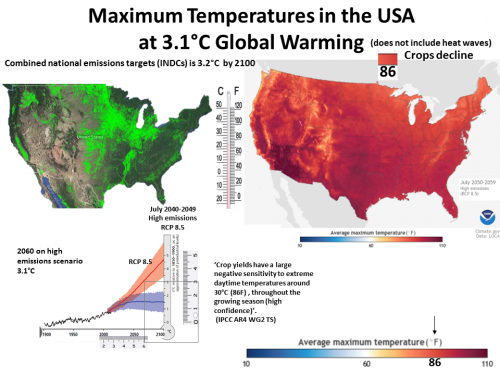
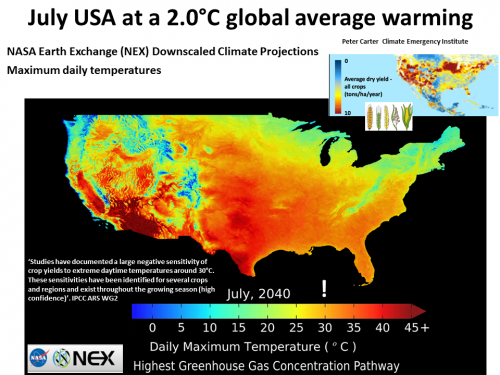
US drought Note 3.2C by 2100 is the projected warming from national emissions targets

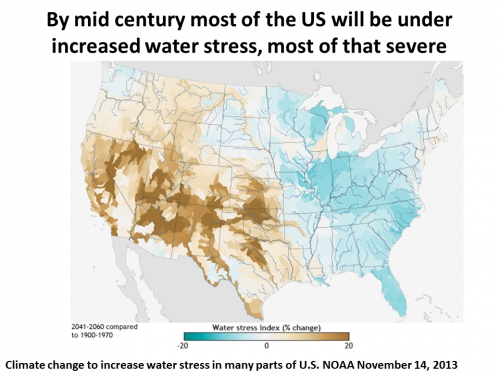
Source of maps NOAA
NASA NEX projected summer maximum actual daily temperatures -at increasing degrees of global warming, with respect to US crops
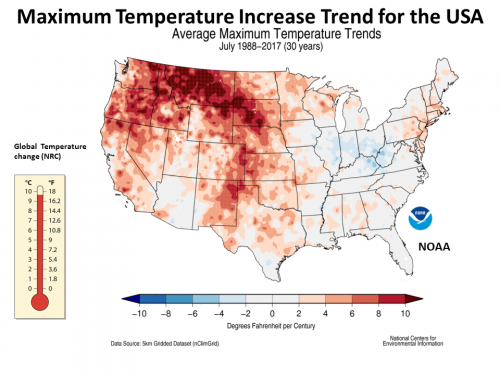
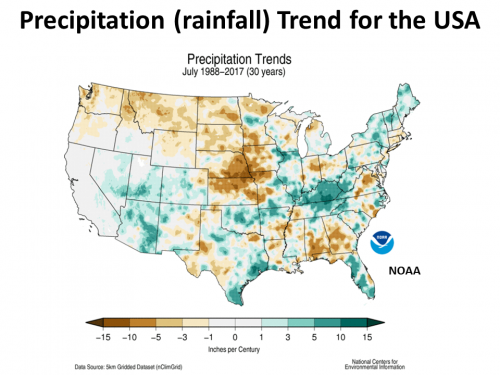
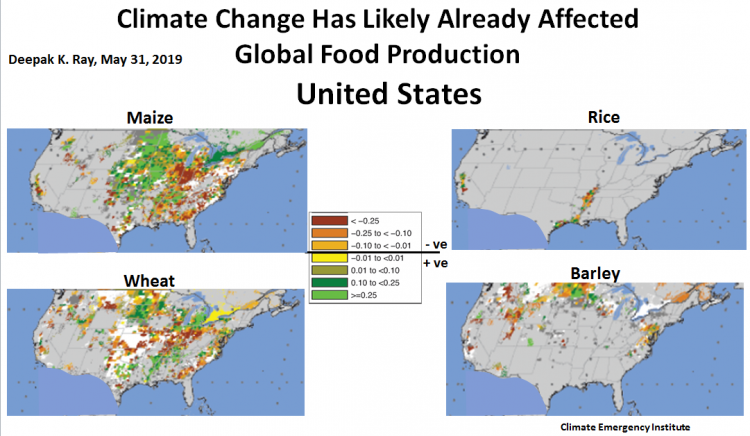
Nonlinear temperature effects indicate severe
damages to U.S. crop yields under climate change
W. Schlenker, Sept 2009
W. Schlenker, Sept 2009
NASA NEX Maximum heat USA
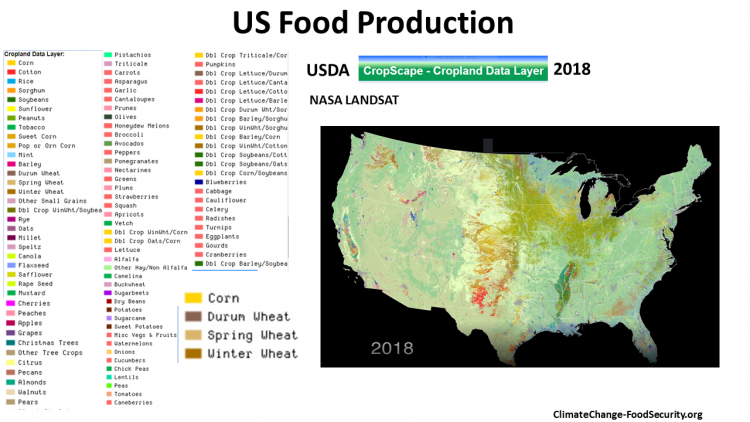
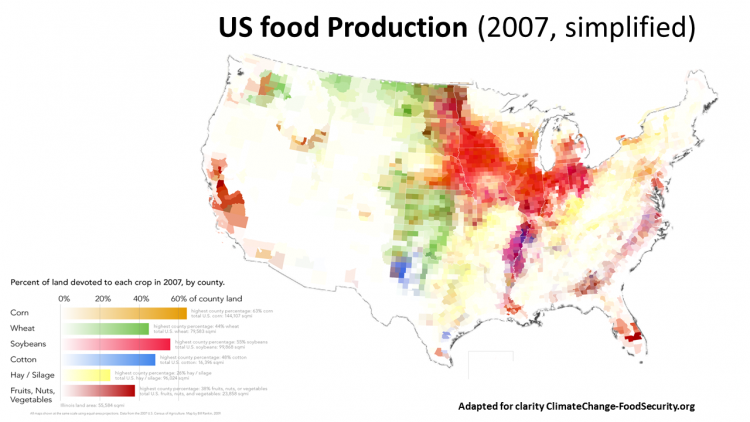
US top world food exporter
The United States, the world's top food exporter, shipped over $139.5 billion in agricultural products abroad in 2018, a $1.5 billion increase over 2017.(4th NCA)
Any climate change compromise to US productivity will severely impact the most vulnerable regions such as Africa and low latitudes
April 2021, Ariel Ortiz-Bobea , Anthropogenic climate change has slowed global agricultural productivity growth
17 April 2020, A. Park Williams, Large contribution from anthropogenic warming to an emerging North American megadrought
2017 Xin-Zhong Liang Determining climate effects on US total agricultural productivity
As the world’s leading food commodity producer, it is critical that the United States sustain its growth in the future to support increasing domestic and global needs.
Jan 2017 Consistent negative response of US crops to high temperatures in observations and crop models, Bernhard Schauberger et al
2018 Fourth National Climate Assessment (USA)
9. Agriculture and Food
The United States, the world's top food exporter, shipped over $139.5 billion in agricultural products abroad in 2018, a $1.5 billion increase over 2017.(4th NCA)
Any climate change compromise to US productivity will severely impact the most vulnerable regions such as Africa and low latitudes
April 2021, Ariel Ortiz-Bobea , Anthropogenic climate change has slowed global agricultural productivity growth
17 April 2020, A. Park Williams, Large contribution from anthropogenic warming to an emerging North American megadrought
2017 Xin-Zhong Liang Determining climate effects on US total agricultural productivity
As the world’s leading food commodity producer, it is critical that the United States sustain its growth in the future to support increasing domestic and global needs.
Jan 2017 Consistent negative response of US crops to high temperatures in observations and crop models, Bernhard Schauberger et al
2018 Fourth National Climate Assessment (USA)
9. Agriculture and Food
Rising temperatures, extreme heat, drought, wildfire on rangelands, and heavy downpours are expected to increasingly disrupt agricultural productivity in the United States. Expected increases in challenges to crop health, declines in crop yields and quality, and changes in extreme events in the United States and abroad, threaten rural livelihoods, sustainable food security and price stability.
Climate change presents numerous challenges to sustaining and enhancing crop productivity, livestock health and the economic vitality of rural communities. While some regions such as the northern great plains may see conditions conducive to expanded or alternative crop productivity over the next few decades, overall yields from major U.S. crops are expected to decline as a consequence of increases in temperatures, possibly changes in water availability, soil erosion and disease and pest outbreaks. Increases in growing temperatures during the growing season in the Midwest are projected to be the largest contributing factor to declines in the productivity of U.S. agriculture. Projected increases in extreme heat conditions are expected to lead to further heat stress for livestock which can lead to large economic losses for producers. Climate change is also expected to lead to large scale shifts in the availability and prices of many agricultural products around the world with corresponding impacts on U.S. agricultural producers, and the U.S. economy. These changes threaten future gains in commodity crop production and poor rural life hoods at risk
2015, USDA, Climate Change, Global Food Security, and the U.S. Food System
The assessment finds that climate change is likely to diminish continued progress on global food security through production disruptions leading to local availability limitations and price increases, interrupted transport conduits, and diminished food safety, among other causes. ...damaging outcomes become increasingly likely in all cases from 2050–2100 under higher emissions scenarios.
As climate change continues and temperature increases of 1–3 °C are coupled with
The assessment finds that climate change is likely to diminish continued progress on global food security through production disruptions leading to local availability limitations and price increases, interrupted transport conduits, and diminished food safety, among other causes. ...damaging outcomes become increasingly likely in all cases from 2050–2100 under higher emissions scenarios.
As climate change continues and temperature increases of 1–3 °C are coupled with
changes in precipitation timing and intensity, yields and farm returns are projected to decline. The
continued changes expected between 2050 and 2100 under high-emissions scenarios are expected to have overall detrimental effects on most crops and livestock. Finally, it should be recognized that there is a significant chance that current projections underestimate potential declines, because most analyses exclude production constraints arising from increased pest pressures, extreme events, and decreased ecosystems services
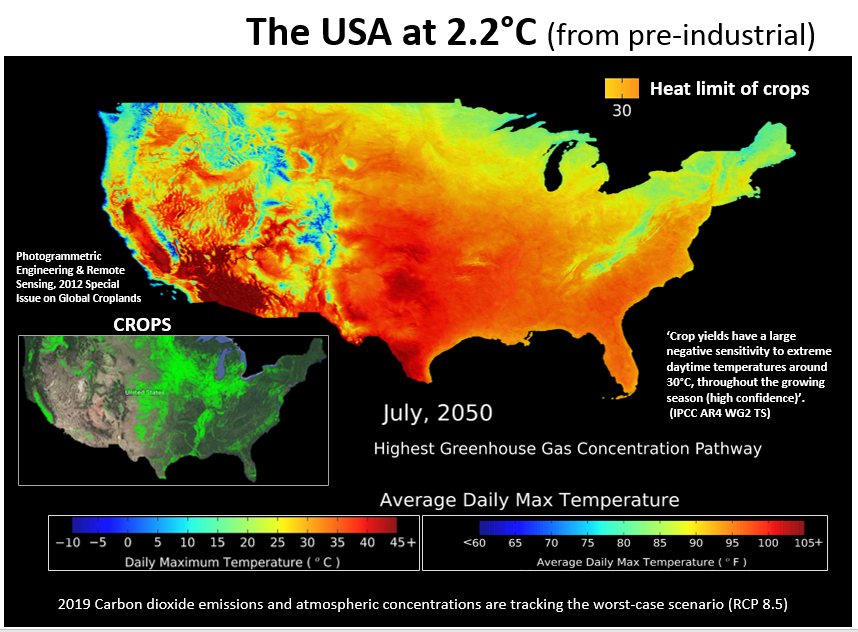
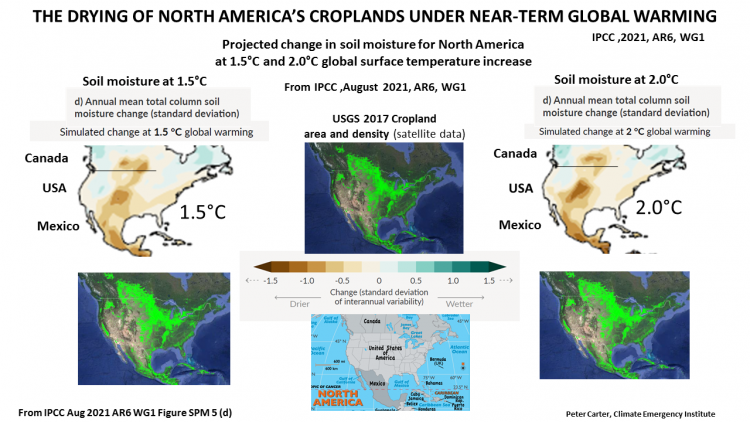
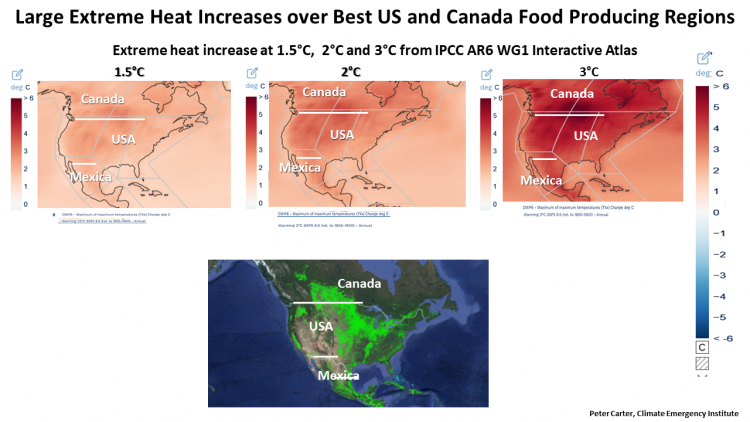
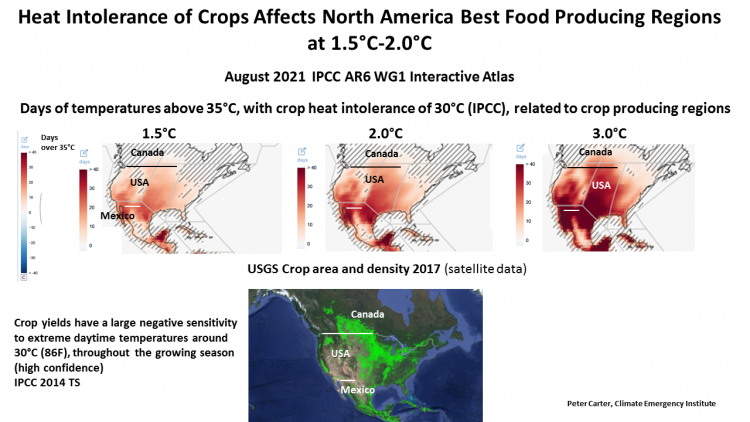
US 2017, Consistent negative response of US crops to high
temperatures in observations and crop models,
Bernhard Schauberger et a.
Bernhard Schauberger et a.